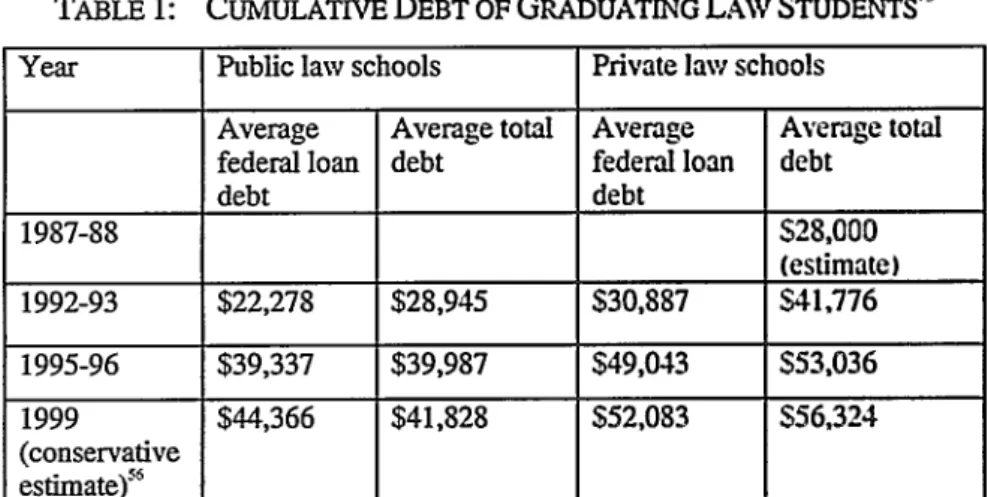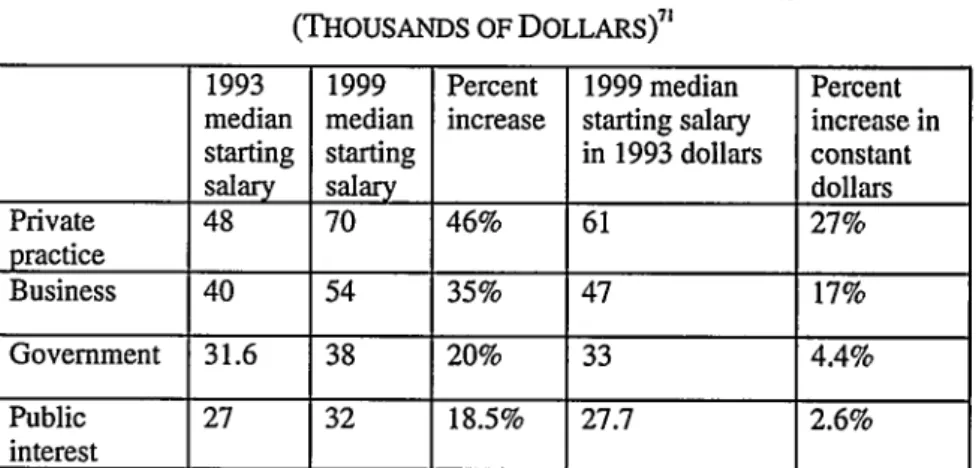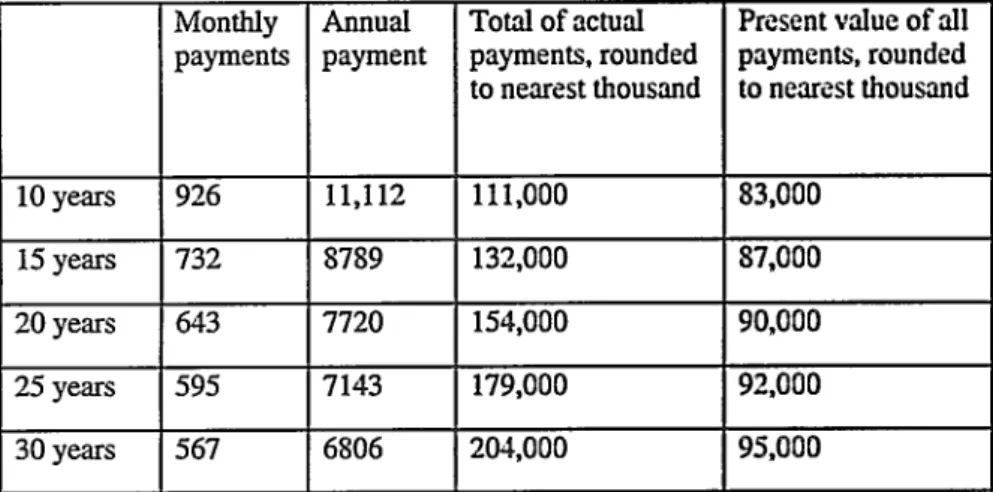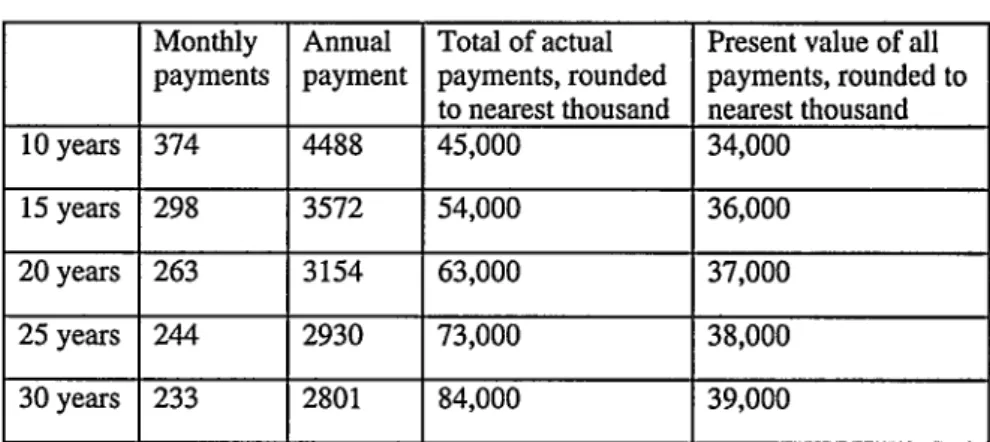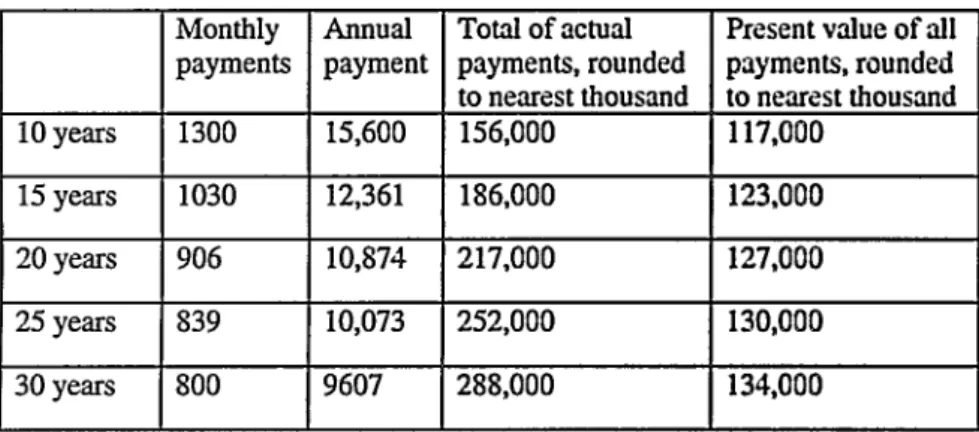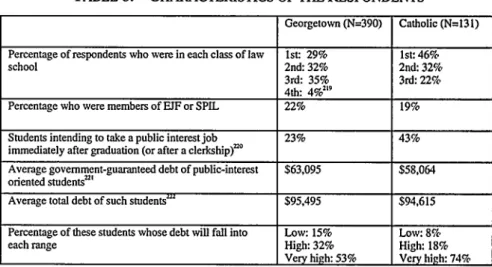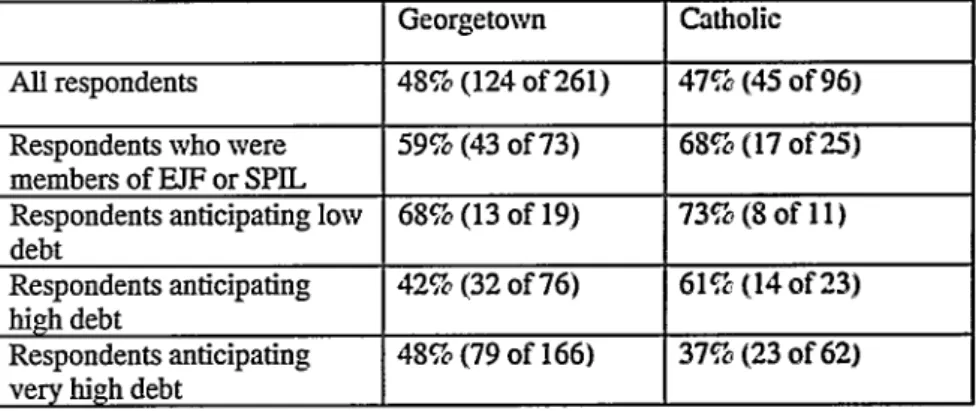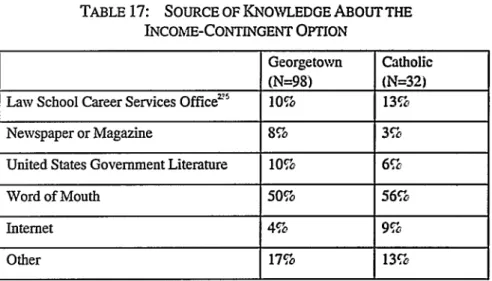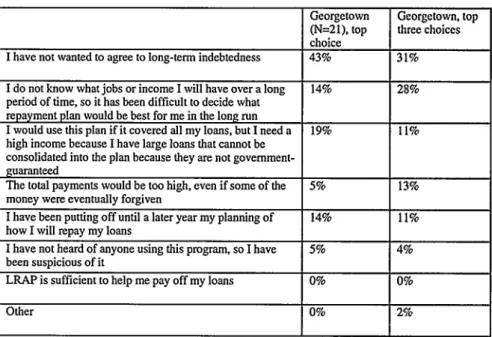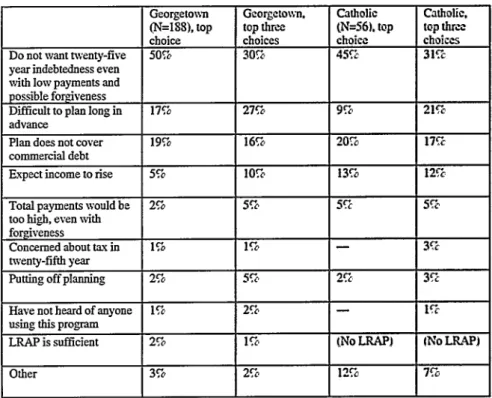Georgetown University Law Center Georgetown University Law Center
Scholarship @ GEORGETOWN LAW
Scholarship @ GEORGETOWN LAW
2001
The Federal Income-Contingent Repayment Option for Law
The Federal Income-Contingent Repayment Option for Law
Student Loans
Student Loans
Philip G. SchragGeorgetown University Law Center, schrag@law.georgetown.edu
This paper can be downloaded free of charge from: https://scholarship.law.georgetown.edu/facpub/225
29 Hofstra L. Rev. 733-862 (2001)
This open-access article is brought to you by the Georgetown Law Library. Posted with permission of the author. Follow this and additional works at: https://scholarship.law.georgetown.edu/facpub
G
EORGETOWN
L
AW
Faculty Publications
February 2010
The Federal Income-Contingent Repayment
Option for Law Student Loans
29 Hofstra L. Rev. 733-862 (2001)
Philip G. Schrag
Professor of Law
Georgetown University Law Center
schrag@law.georgetown.edu
This paper can be downloaded without charge from:
Scholarly Commons:
http://scholarship.law.georgetown.edu/facpub/225/
THE FEDERAL INCOME-CONTINGENT
REPAYMENT OPTION FOR
LAW STUDENT LOANS
Philip G. Schrag*
* Professor of Law and Director of the Center for Applied Legal Studies, Georgetown University Law Center. I am very deeply indebted first and foremost to Ruth Lamm.it-Rcevec, Georgetown's outstanding Assistant Dean for Financial Aid, for helping to educate me about loan repayment plans and options, and for guiding me to many helpful documentary materials. In the course of talking with other law school financial aid advisors. I learned how much is. Lammert-Reeves is admired in her professional community, and I came to understand the wel-dzsered basis of her high standing there. The research for this Article was supported in pat by a grant from the Open Society Institute, and in part by writing grants from Georgetown University Lav. Center, which were made available by Dean Judith Areen. I am grateful for both sources of assistance. I also appreciate the enormously important contributions of my student research assistants, Lewis Walton, Benjamin Gardner, and Tai-yeu Hsia. Thanks are due, as well. to Professor Lisa Lerman of Catholic University Law School, who distributed my questionnaires to her institution: to the hundreds of students at Georgetown and Catholic Universities, ninety-eight financial aid advsors, fifty-seven directors of legal aid offices and public interest law firms, vho answared my questionnaires; and to several officials of the Department of Education %ho took time to explain to Mr. Hsia and me the methods of the Department's income-contingent calculations. I also appreciate the outstanding work of Decision Research Inc., vhich computed the data from the student and financial aid advisor surveys, and I am grateful for the valuable comments by Stephen Brown, David Jaffe, Elliott Milstein, Daniel L. Pollard, Mark Kantrowitz, and members of Georgetown's faculty scholarship workshop on earlier drafts of the Article. Finally, I appreciate the cooperation of Mark Kantrowitz. Mr. Kantrowitz created a Web-based version of the income-contingent loan calculator that Mr. Hsia and I developed so that the charts in this Article could be compiled. See Mark Kantrowitz, Income Contingent Repayment Calculator, FinAid: The SmartStudent Guide to Financial Aid, at http'/wv,v.finaidorg/calculatorsicr.phtml (last visited Feb. 13, 2001) (providing the FimAid income-contingent repayment calculator). HnAid is a nonprofit, public interest distributor of loan information for students; it provides a clear, up-to-date explanation of student loans and various calculators through which students compute monthly payments and total costs of various types of loans. See id. If for some reason that Wcb site ceases to be opcrational, the Hsia-Schrag Microsoft Excel spreadsheet through which the same calculations can be performed is also posted. See Tai-yeu Hsia & Philip G. Schiag, Income-Contingent Lean Repaymcnt and Stea13
Repayment Calculators, Georgetown University Law Center, at
http.//data.law.georgetovaedu/faculty/shragfloanrepayment.tml (last modified July 20, 2000). The FinAid version is, however, much more user friendly and I therefore recommend that version. The research reported in this Article will be published in book form under the title, REPAY AS YOU EARN: THE GOVERNMNT'S FLAWED PROGRAM TO HELP STDTuS HAVE PUBmC SEPvIC CAREERS (forthcoming 2002).
CONTENTS
I. INTRODUCTION ...
736
II. RISING COSTS AND RISING DEBT ...
740
A. The Rising Cost of Legal Education ... 740
B . D ebt ... 742
C. The Pressure on Public Interest Lawyers ... 749
D. The Case for a Subsidy ... 755
E. Effects on Nonprofit Public Service Institutions and Their Clients ... 757
F. Effects on Individual and Family Consumers of Legal Services ... 759
G. Effects on Law School and Legal Culture ... 760
H. Effects on Law Students ... 760
III.
CONGRESS TO THE RESCUE ... 764A. The 1993 Legislation ... 764
B. The Income-Contingent Repayment Formula ... 770
IV. WHAT IS REALLY (NOT) HAPPENING OUT THERE ...
774
A . Law Students ... 774
B. Financial Aid Advisors ... 793
V. Is INCOME-CONTINGENT REPAYMENT GOOD FOR YOU? ... 803
A. Larry and Lisa Lifer, Public Interest Careerists ... 806
B. Ralph Reformer, Test Case Litigator ... 813
C. Cindy Civic, Serving the Poor First and Getting Rich L ater ... 815
D. Fay Federal, Justice Department Lawyer ... 817
E. Max Merger, Corporate Lawyer ... 818
F. The Effects of LRAP ... 820
G. The Effects of Marriage ... 827
VI. WHY INCOME-CONTINGENT REPAYMENT Is So UNPOPULAR ... 830
VII. RECOMMENDATIONS ... 840
A. High-Debt Law Students Considering Low-Income Jobs ... 840
B. Law School Financial Aid Advisors ... 844
INCOME-COV-I'INGENTREPAYAiENTOPTION
VIII.
AF ERWORD ... 858Many idealistic law school graduates feel precluded from taking legal aid and other low-paying public service jobs because they have incurred high educational debt, often exceeding $100,000. In 1993, however, Congress created an "income-contingent" debt repayment option that was intended to enable high-debt, low-income graduates, including lawyers, to afford accepting public service positions.' This program caps loan repayments at a reasonable percentage of the graduates' incomes, and it forgives any remaining balance at the end of twenty-five years.2 To date, this program has failed to meet the needs of public interest lawyers. It is rarely used. Law students are largely unaware of it. Those who do know about the program, including law school financial aid advisors and the minority of law students who have heard of the plan, are suspicious of it. The main problem is that the twenty-five year repayment term is too long a period to be considered seriously by people just starting their careers, even though the plan also offers subsidies. This Article argues that the Secretary of Education should use existing statutory authority to shorten the term to a more realistic fifteen years, at a relatively low cost. It also argues for other reforms, including better marketing of this program by the United States Department of Education ("Department").
Even as presently constituted, this program is potentially valuable for some law graduates who do not presently use it. As a long-term repayment measure, it would be particularly advantageous, offering generous subsidies for those whose schools do not have Loan Repayment Assistance Programs ("LRAPs") and who start at quite low salaries, expect only modest income increases over time, and want to spend their full careers in public service. For those who want to spend a few years in public service early in their careers, this federal program could be useful as a temporary measure, and it permits students to convert to more conventional repayment plans when their incomes increase substantially.
With assistance from the Author and Tai-yeu Hsia, FinAid (a public interest organization that helps students understand the loan system) has created a World Wide Web ("Web") based calculator that enables readers of this Article to determine for themselves how the income-contingent repayment plan would affect their repayment obligations and
1. See generally infra Part 13L
2. See infra note 180 and accompanying text: discussion infra Part IlH.B.
their total costs. An explanation of this calculator and its location on the Web are included in this Article.
I. INTRODUCTION
Most law students graduate with very high educational debt. For some, the debt can without exaggeration be described as "staggering," in the sense that repayment according to a "standard" ten-year schedule would leave the graduate with full-time employment but scant discretionary income. Such a graduate can survive only by sacrificing consumer goods and services, postponing having a home and a family, and accruing additional credit card debt. The loan repayment problem is greatest for law students who would like to be self-sacrificing up to a reasonable point: those who decide to go to law school because they want to serve the public as "public interest" lawyers, such as staff attorneys at legal aid organizations. These students enter law school aware that public interest lawyers are paid only a small fraction as much as big-firm lawyers.3 But only as they accumulate law school debt do they realize that loan repayment obligations significantly increase the pressure to take high-paying private sector jobs. As graduation approaches, many of these students feel, with some bitterness, that because of their law school debt, they have no choice but to abandon their original goals and to seek employment with large corporate law firms, where starting salaries (including bonuses) often exceed $90,000 and now sometimes exceed $160,000.'
Approximately a third of the nation's law schools have LRAPs to subsidize loan repayment for graduates who decide to work in public interest jobs.' But most law schools do not have such programs, and some programs are not funded well enough to meet students' needs.6
In 1993, with strong encouragement from the newly elected President, Bill Clinton, Congress seemed to come to the aid of graduates who faced the prospect of high debt and low incomes. When it established a program of direct lending to students by the Department, it created an "income-contingent repayment option" through which annual repayment of most educational debt would be capped at a fraction of the
3. See David L. Chambers, The Burdens of Educational Loans: The Impacts of Debt on Job
Choice and Standards of Living for Students at Nine American Law Schools, 42 J. LEGAL EDUC. 187, 192 (1992).
4. See infra note 73 and accompanying text.
5. See discussion infra Part IV.B. 6. See discussion infra Part IV.B.
INCOME-CONTINGENTREPAYMENT OPTION
graduate's income! The option would be available to all graduates, not
only of law schools, but also of undergraduate colleges and other
graduate and professional schools.8 Students who paid through this planfor many years might temporarily accumulate mounting indebtedness
because of the income-based cap on repayment. But the remaining debt would be canceled after twenty-five years of capped repayments.Furthermore, the graduates of schools that did not participate in the
government's direct lending program could take advantage of the optionthrough a consolidation loan from the federal government after
graduation.'
0Shortly after its enactment, this new law was hailed as a "radical"
change.
1According to Steven Waldman, the Newsweek legislative
correspondent who closely followed the progress of this legislation sothat he could write a book about its progress through Congress, the law
meant [that] anyone who still hadn't paid off their loan by year twenty-five would get an enormous gift from the taxpayers. The biggest benefit of all would go to ... doctors who work in low-income clinics or lawyers who become public defenders-in other words, those doing the public service jobs Clinton admired.
Eight years later, despite these apparent attractions, the
income-contingent repayment option seems not to have caught on, at least
among law graduates. Is neglect of this "program"'
' 3justified by its
economic disadvantages or the availability of good substitutes? Or is it
based at least in part on non-economic factors such as lack of
information about its availability, the difficulty of computing the totalcost of income-contingent borrowing, distrust of the federal government,
or fear of unconventional financial devices? To put it another way, in the
7. See discussion infra Part ilLB. 8. See 20 U.S.C. § 1091(a)(1) (1994).
9. See discussion infra Part IILB.
10. See discussion infra Part IILB.
11. See STEVEN ALD N, THE BI=L How THE ADVENTuRES OF CLLUNro:N's NATION;AL SERVICE BILL REVEAL WHAT Is CORRUPr, COMIC, CYNICAL-AND NOBLE-.ABOUr WVAS HINGTON; 236 (1995). This book is a study of the interactions between Congress and the Clinton
Administration during legislative consideration of two bills: the law establishing a national scrvice corps and the law creating a federal direct educational loan program. See generally id. app. at
251-52.
12. Id. at 236. At present, the "enormous gift" is taxable, but that aspect can and should bz
changed. See infra notes 394,446 and accompanying texL
13. In this Article, the option is referred to, for convenience, as a "program." even though the
government does not do so. The United States Department of Education ("Department") regards income-contingent repayment as one formula among several others for paying bach- student loans,
and the administration of direct lending and its repayment is the government's "program." 2001]
future should law students who are graduating with very high debt loads consider signing up for income-contingent repayment if they would prefer to have public service careers, or jobs in small law firms that serve individuals, rather than working for the large law firms that pay the highest salaries? If the income-contingent repayment option is not living up to its promises, at least for significant numbers of high-debt, low income public servants, how should it be changed?
Part II of this Article explores the amount of indebtedness and the expected incomes of recent law graduates. It examines the historic and recent literature on the extent of their debt, relating the current economic situation of indebted law graduates to the trends of tuition and debt in recent decades.
Part III reviews the objectives and history of the legislation establishing an income-contingent loan repayment option. The legislative history demonstrates a broad consensus in favor of assisting students who planned public interest careers. Part III also explains the mechanics of income-contingent repayment and debt forgiveness under
the law and its implementing regulations.
Part IV reports the results of the Author's survey of law students' knowledge of the income-contingent repayment option, and, to the
extent that they know about it, their attitudes about this method of payment. Because students in most schools must rely on law school financial aid advisors for information and counseling about loan repayment options, Part IV also reports the results of the Author's
survey of law school financial aid advisors' awareness of and beliefs about income-contingent repayment. These surveys provide statistical evidence supporting the hypothesis that this program is poorly understood and little used by one of the important constituencies for whom it was intended.
The surveys reveal that while neither students nor financial aid advisors are well informed about the income-contingent repayment option, those who are informed shun it, though for different reasons. Students dislike it primarily because it requires at least an initial commitment to a twenty-five year repayment schedule. Financial aid advisors are skeptical of it because they believe that few graduates would use it long enough to obtain its promised subsidies. However,
52% of the financial aid advisors believe that income-contingent repayment could be useful for at least 5% of their schools' recent graduates.
Having surveyed in Part IV the background of opinions about this program and the sources of the respondents' misgivings, Part V
2NCOME-CONTINGENTREPAYMENT OPTION
considers the income-contingent repayment option from the perspective
of some hypothetical recent graduates unhampered by either a lack of
information about the program or distortions of its cost. From the
perspective of hypothetical law students with high debt and different
plans for long-term and short-term public service, Part V demonstrates
the advantages and disadvantages of income-contingent repayment
compared with standard repayment and with other long-term repayment
plans. It also considers the effect of the availability of a law school loan
repayment assistance plan, and of marriage, on the value of using
income-contingent repayment. In addition, it directs students to a new
Web site through which they may make their own personal calculations
of how they would fare under the income-contingent plan, and through
which they can compare income-contingent and standard repayment.
Part V may enable future law students to make more rational debt
repayment and career decisions, and it may help financial aid advisors to
offer more sophisticated guidance.
Part VI asks why a plan that has been part of the federal law for
more than five years, and that could help make loan repayment
affordable for law graduates most in need of assistance, is so little
understood or used. The existence of alternative payment-reduction
plans does not adequately explain the orphan status of
income-contingent repayment. Part VI considers, as well, inadequacies in the
program itself; the impact of private lender hostility to the program and
of partisan politics; and the poor quality of public information issued by
the Department.
Part VII makes recommendations to students, to financial aid
advisors, and to policy makers in Congress, the White House, and the
Department. It offers students some advice on financial planning within
the constraints of the existing loan repayment system, and it encourages
financial aid advisors to become more familiar with how
income-contingent repayment can be useful for graduates with the highest debt
and lowest incomes, particularly those who are committed to a lifetime
of full-time public service. On the assumption that policy makers are
now or will in the future be guided by the same desire to encourage
public service that motivated legislators and President Clinton to create
income-contingent repayment in 1993, it makes several suggestions for
making this program more attractive and more visible to borrowers who
desire to become public interest lawyers.
II. RISING COSTS AND RISING DEBT
A. The Rising Cost of Legal Education
For nearly fifteen years, observers of legal education have warned that the rapidly increasing cost of becoming a lawyer would eventually have deleterious effects on the profession. In 1987, John R. Kramer, then-Dean of Tulane Law School, noted that from 1974-75 to 1985-86, private law school tuition had increased from an average of $2305 to an average of $8286 (259%), and public law school tuition for in-state students had increased from $716 to $2135 (198%)." During this same period, the consumer price index had risen only by 120%."5
Kramer projected the trend forward to the year 2000, assuming three different rates of tuition increases: the 11.3% historical rate for private law schools, a more moderate 7% rate, and a low 5% rate.6 He assumed that students would continue to borrow at the same rate as in the past to pay for legal education.17 He concluded:
Student borrowing would have to climb to at least $66,000 to cover the 73% of average private law school attendance costs (at the low predicted rate of inflation in tuition) now covered by the [federal guaranteed student] annual loan limit.... Because [the median] starting salary of $36,000 in 1982 will become $82,500 in 2003, assuming a 5% annual increase, a $66,000 debt might be barely affordable."
But, he noted, half of the graduates would be earning less than the median.9
The effect of these escalating costs and debt, Kramer worried, would be that law schools would "be filled with many more students who, as they become lawyers, do so with the single-minded objective of milking the profession for all it is worth in order to be able to pay retrospectively for their legal education."2 Two years later, he noted that faced with continuing increases in the cost of legal education, some talented college graduates would give up their desire to become lawyers,
14. See John R. Kramer, Will Legal Education Remain Affordable, By Whom, and How?, 1987 DuKE L.J. 240, 242-43.
15. See id. at 243. 16. See id. at 244.
17. See generally id. at 250-68. 18. Id. at 267.
19. See id. 20. Id. at 240-41.
INCOME-CONTINGENTREPAYMENT OPTION
and that students who did choose law school would "recoup their
investment by ignoring the legal needs of four-fifths of the nation in
order to service the one-fifth able to pay sizeable fees."'" "How do you
expand the range of career choice for graduating students saddled with
tens of thousands of dollars of debt burden," he asked.? "Or do you
simply tighten the corporate large firm practice noose around their necks
and yank?"3
Professor David Chambers responded contemporaneously "that in
some respects Kramer is not nearly gloomy enough."24 He noted that
Kramer failed to explore in any detail the situation of law graduates who
incurred the same law school expenses as everyone else but earned well
below the median salary.2- Chambers feared that in the future "it may
well become harder and harder to attract able beginning lawyers into
government, legal services, and 'public interest' work."
'Chambers had
some empirical data to support his concern. A survey of Michigan Law
School graduates showed that "nearly half of those with debts of
$15,000 or more who were currently working in government, legal
services, public defenders or other public interest settings reported that
they had experienced moderate to great difficulty in meeting their
obligations,"
2'and he predicted that with the cost of a legal education
rising more quickly than inflation, "the starting lawyer with high debts
will be substantially worse off in 1997 than in 1987.""
Kramer's 1987 predictions of the cost of attending a private law
school in the year 2000 proved accurate.
:' By 1999, the average tuition at
such a school had become nearly $21,000, 9 and the average annual cost
21. John R Kramer, lWo Will Pay the Piper or Leave the Check on the Table for the Other
Guy, 39 J. LEGALEDUC. 655,655 (1989). 22. IL at 671.
23. Id.
24. David L. Chambers, Educational Debts and the Worsening Position of Small.Firm.
Government, and Legal-Senices Lmtyers, 39 J. LEGAL Ecc. 709, 709(1989). 25. Seeid.at709-10.
26. Id.at710. 27. Ld. at719. 28. Id. at 722.
29. Kramer predicted annual 2000-01 cost of attendance for private law school in the range of $29,000 to $55,000. See Kramer, supra note 14, at 245. He put the cost of public law schoal attendance in the $16,700 to $20,200 range. See id.
30. The precise private school tuition average was S20,709. See E-mail from Rick L Morgan, American Bar Association, to the Author (June 13, 2000, 15:02 EST) (on file with author); see also Michael A. Olivas, Payingfor a Lav Degree: Trends in Student Borrowing and the Ability to Rep r
Debt, 49 J. LEGAL EDUC. 333, 333 tbl.1 (1999) (displaying the published figures for 1975 anJ
1997). Olivas (who is the William B. Bates Professor of Law at the University of Houstono %Ias a trustee of the Access Group, a major private lender, and his data was supplied by Access Group. See
of attendance (measured by tuition plus living expenses) had risen to $32,763.3" Even by 1997, the cost of attendance at fifty of the nation's 180 law schools had exceeded $30,000 per year, and several schools were considerably more costly,32 causing one scholar to observe that students entering some law schools in 2002 "will have to shoulder costs of attendance of more than $155,000 for their three years of schooling."'33
For students attending public law schools in their own states, in which
legislative appropriations subsidized their education significantly, the 1999 cost was considerably less than at private law schools; studentsliving off campus paid an average of only $18,415 for each of their three
years.' But tuition costs at such schools had been rising more quicklythan at private law schools.
35B. Debt
Lending is the engine that makes it possible for students to attend
law school.36 Approximately 86% of law students borrow to pay for theireducation.
37Students take out two types of loans: (1) they incur debt that
is guaranteed by or extended by the federal government; and (2) theyalso borrow commercially. Because it is less costly, they borrow first, to
the extent permitted by law, through the federal Stafford loan program."id. at 333 & n.1. From 1997-98 to 1998-99, tuition at American Bar Association (ABA") approved
law schools increased 6%, compared to a national inflation rate of 1.6%. See id.
31. See E-mail from Rick L. Morgan to the Author, supra note 30 (noting that the cost of living off campus while in law school for a year is an additional $12,054 (public and private law schools combined)). By another measure, which counts into the cost of legal education the lost wages that the student could have earned while attending law school, the cost of attendance Is considerably greater. See Kramer, supra note 14, at 247.
32. See Olivas, supra note 30, at 334. 33. Id.
34. See E-mail from Rick L. Morgan to the Author, supra note 30 (noting the 1999 public law school tuition for in-state residents and off-campus living expenses).
35. Average public law school tuition for in-state residents rose from $780 to $6000 between 1975 and 1997. See Olivas, supra note 30, at 333 tbl.1. Average in-state tuition rose another 6% in 1998 and a further 6% in 1999. See E-mail from Rick L. Morgan to the Author, supra note 30.
36. Some students receive money from parents for law school attendance, but even in 1987 John Kramer could write that "[m]ost students are given either more than $10,000 or nothing at all," and that the emergence of a large federal lending program was "encourag[ing] some parents to abandon a previously accepted responsibility," causing students to have "to find money for legal education themselves." Kramer, supra note 14, at 252.
37. Eighty-six percent of lawyers graduating in 1996 had borrowed. See SAMUEL M. KiPp, 111,
STUDENT BORROWING, DEBT BURDEN, AND DEFAULT: THE SPECIAL CASE OF
FIRST-PROFESSIONAL STUDENTS IN THE 1990S, at 25 (Access Group, Inc. 1998). An increasingly high percentage borrow as the cost of attendance rises; the corresponding percentage for the class of
1993 was 81%. See id.
38. See generally 20 U.S.C. §§ 1078, 1078-8 (1994 & Supp. IV 1999). Students with exceptional financial need may also borrow up to $6000 per year (for graduate students) through the
INCOME-CONTINGENTREPA YMENT OPTION
Government-guaranteed Stafford loans can be obtained from banks for
undergraduate education, for legal education, or for both, through theFederal Family Education Loan Program ("FFELP")' known in a
pre-1992 incarnation as the federal guaranteed student loan program:i Atsome universities, students may borrow directly from the federal
government, through its federal direct lending program, rather than from
banks." Stafford loans are extended at rates lower than the commercialmarket would charge, and they are subject to a statutory interest rate
ceiling of 8.25%.42 Only 1% of law students borrows for college but notfor law school
4 3Fifty-three percent borrow for law school." Another
32% borrow for both levels of education."sThe Stafford loan program includes two types of loans. The first
$8500 per year that most law students borrow is subsidized," in that the
federal government pays the interest while the student is in school:
After borrowing $8500 this way, a student may also borrow up to an
additional $10,000 per year in unsubsidized Stafford loans."3 As in thecase of subsidized Stafford loans, the interest rate is linked annually to
the rate for ninety-one day Treasury bills," but the maximum rate is
Perkins Loan Program, in which the interest rate is capped at 5%. Sce id. § 10$7dd(all21 A11ii, (c)(1)(D) (Supp. IV 1999); see also ANNE STOcKWLJ, THE GUtERRIUA GUIDE TO MASTu'JxG
STuDENT LoAN DEBT 50-58 (1997) (discussing the history of financial aid). This manual, written for students, is a well-known introductory orientation to the institutions that manage student loan programs. It contains much useful history of federal financial aid, and it offers considerable help with terminology and concepts. See id However, it does not describe repayment plans in detail.
39. 20 U.S.C. §§ 1071 to 1087-4 (1994 & Supp. IV 1999).
40. See STOCKwEL, supra note 38, at 59.
41. See 20 U.S.C. § 1087a(a) (1994).
42. See id. § 1077aj)(1), (k)(1) (Supp. IV 1999) (describing original loans); id. § 1087e(b)(6)(C) (describing consolidation loans).
43. See Kipp, supra note 37, at 25 tbl.7.
44. See i&
45. See id.
46. Eligibility rules for subsidized Stafford loans to law students are sufficiently generous that an estimated 95% to 97% of the Georgetom University Law Center ("Georgetowm") law students who borrow receive subsidized Stafford funds. See E-mail from Ruth Lammut-Reeses, Assistant Dean for Financial Aid, Georgetown University Law Center, to the Author (July 21, 2000, 12:27 EST) (on file with author).
47. See 20 U.S.C. § 1077a(k)(2) (Supp. IV 1999).
48. See id. § 1078-8(d)(2)(C). If the student is not eligible to borrow the full $35040 in subsidized Stafford funds, he or she may borrow that money as part of the unsubsidized Stafford loan. See id. § 1078-8(a), (b) (1994 & Supp. IV 1999).
49. The rate is 1.7% more than the ninety-one day rate for the previous May %, hila the borrower is in school and for a short time thereafter, and 2.3% above that rate for the duration of repayment. See id. § 1077a(j)-(k) (Supp. IV 1999). For loans that are consolidated, the interest rate becomes fixed; itis the weighted average of the rate being paid for each of the consolidated loans at the time they are consolidated, rounded up to the nearest higher one-eighth of 1"%, with a cap of 8.25%. See id. § 1077a(k)(l), (4).
8.25%." However, although a student may defer paying interest on the unsubsidized Stafford loan while in school, the unpaid interest is added
to principal (capitalized), so it will cause the size of the loan to increase.
Because the cost of attendance at many law schools exceeds the
$18,500 that may be borrowed through Stafford loans, many students
turn to private lenders to make up the difference. Typically, they turn to private lending programs that are specifically geared to law students,
such as those offered by the Access Group, a major lender in this field.
Because the loans are not government-guaranteed, these programs charge higher rates of interest than the banks or the government charge on Stafford loans." But some students do not qualify to receive sufficient credit from these private lending programs to cover all of their educational expenses. Some students are driven toward still moreexpensive private borrowing. For example, graduate students in the
United States have an average of seven credit cards, and the average cumulative balance on these cards is $5800.2 Credit card interest rates are often 16% to 18% per year.In 1995-96, approximately one-quarter of all students at private law
schools had private loans on top of their Stafford loans." This percentage
was bound to keep rising, at least until 2003, because while law schoolcosts kept going up, the $18,500 annual limit on Stafford loans set by
Congress in 1992 was not changed in the congressional review of theHigher Education Act in 1997, and is not scheduled for further
legislative review until 2002-03.-4 When the annual Stafford limits are eventually increased, the amount of private lending may fall, but theamount of total borrowing will continue to increase.
50. See id. §§ 1077a(k)(1), 1078-8(e)(4) (1994 & Supp. IV 1999).
51. See Jane Bryant Quinn, New Schools of Thought on College Loans, WASH. POST, Nov. 14, 1999, at H2.
52. See Michael A. Olivas, Diane L. Saunders & Mel R. Stiller, The Challenge of Paying for
a Graduate or Professional Degree: Trends in Student Borrowing and the Ability to Repay Debt, In
SYMPOSIUM ON HIGHER EDUCATION FINANCING: CRITICAL CHALLENGES IN FINANCING GRADUATE
AND PROFESSIONAL DEGREES 47, 57, Access Group, available at
http://www.accessgroup.org/symposiumlacrobat/chapt3.pdf (Sept. 1997) [hereinafter SYMPOSIUM] (providing the comments of Diane Saunders, Vice President of Communications & Public Affairs at Nellie Mae). Nine percent of graduate students have credit card balances exceeding $15,000. See
id.; see also Susan Carpenter, Bankrupt at 24: For More and More Young Adults, Credit Cards, Student Loans and Unwise Spending Add Up to Ovenvhelming Debt-And Some Are Using a Last-Resort Measure First, L.A. TIMES, Jan. 23, 2001, at El.
53. See Kipp, supra note 37, at 22 tbl.4.
54. The percentage of law students borrowing from private sources fell (from 36%) after
1992, because in that year, Congress raised the loan limit to $18,500 and made eligibility criteria
much more generous. See Default Rate Dips Again for Student Loans, BUFF. NEWS, Nov. 12, 1997, at 10A. "[M]ore than 60 percent of the increase in cumulative federal borrowing ... was actually the result of substituting lower-cost federal loans for private loans." Kipp,, supra note 37, at 21.
INCOME-CONTINGENTREPAYMlfENTOPTION
The federal indebtedness and the total indebtedness of graduating law students have increased steadily. Table 1 displays this increase.
TABLE 1: CUMULATIVE DEBT OF GRADUATING LAW STUDENTS"
Year Public law schools Private law schools
Average Average total Average Average total federal loan debt federal loan debt
debt debt 1987-88 $28,000 (estimate) 1992-93 $22,278 $28,945 $30,887 $41,776 1995-96 $39,337 $39,987 $49,043 $53,036 1999 $44,366 $41,828 $52,083 $56,324 (conservative estimate)-"
From 1988 to 1996, the cost of living increased by 32.6%, so
indebtedness of $28,000 in 1988 would amount (in 1996) to $37,128 in
1988 dollars. The 1995-96 $53,036 average total debt of private law
school students therefore represents a considerable increase in terms of
real dollars. Similarly, the 1992-93 average total private law school debt
of $41,776 should equate in 1996 to $45,368, not $53,036, if there had
been no real increase.
"From 1987 to 1999, the cost of living went up by
less than 50%,"8 but the average debt of students graduating from private
law schools doubled.55. The data from 1992-93 and 1995-96 were derived by Samuel M. Kipp, III from thz National Center for Education Statistics' National Postsecondary Student Aid Study 1992-93 and National Postsecondary Student Aid Study 1995-96 databases. See KIpp. supra note 37, at 21. They understate total indebtedness because they exclude credit card debt. See id. Good statistics are apparently unavailable before 1992-93. The 1938 estimate is based on an analysis of the cumulative debt ($22,000) of students graduating from Tulane Law School that year who had borro%%ed from Law Access, plus an estimated $6000 of undergraduate debt with v,hich they arrived in law school.
See Kramer, supra note 21, at 672-73.
56. This estimate was derived only by adjusting for 1996-99 inflation, and assuming no real increase in borrowing, even though borrowing has historically outpaced inflation. United States government statistics show that average indebtedness for all 1997 first-professional (not only lav. ) graduates was $66,200. See SUSAN P. CHOY & C. DENNIS CARROLL, U.S. DEP'T OF EDuC., DEBT
BURDEN FOUR YEARS AFrER CO.LEGE 56 (NCES 2000-188 2000).
57. Unless othenvise stated, inflation adjustments in this Article were computed using a particularized inflation calculator. See Consmner Price Index (CPI) Inflation Calculator. Johnson Space Center, at httpJ/www.jsc.nasa.gov/bu2inflateCPLhtml (last visited Feb. 13.2001).
58. The increase over these years vms 46.7%. See id. 2001]
The $56,324 estimate of average debt (for students graduating from
private law schools in 1999) is based on projections from data
self-reported by students in a Department survey, and it may significantly understate the amount of debt. Two recent studies suggest that the debt is actually higher. The National Association of Student Financial AidAdministrators' survey of financial aid administrators found that for law
student borrowers graduating in 1998, average cumulative debt(including undergraduate debt) was $45,536 at public schools and
$63,078 at private schools.9 The Access Group, which probably extendsthe majority of loans to law students," studied the average indebtedness
of 1998 law graduates who had exhausted their three $18,500 Stafford loans and borrowed at least once from the Access Group.6 It found that the average indebtedness of these graduates was $79,851.55, not including accrued undergraduate debt.62Averages can be misleading. Many schools have
higher-than-average tuition or are located in regions in which the cost of living isparticularly high. Also, within high-cost schools, students incur a range
of debt, in part because some bring with them more family resources than others, and some earn more during summers. It is therefore worthnoting that among law students graduating in 1995 from the 10% of law
schools with the highest average indebtedness, the average debt was$68,690.
Some law schools with high average indebtedness of
graduating students in 1998 included California Western School of Law($78,350), Catholic University of America, Columbus School of Law
("Catholic")
($78,500),
Georgetown
University
Law
Center
("Georgetown") ($82,600), George Washington University Law School
($80,050), Stetson University College of Law ($91,897), Tulane Law59. See Kenneth E. Redd, Policies, Practices, and Procedures in Graduate Student Aid: A Report on the 1998 NASFAA SOGAPPP Survey, NASFAA's STUDENT AID TRANscRIr, Spring
2000, at 10, 18 fig.4.
60. Telephone Interview with Jeff Hanson, Access Group Analyst (June 29, 2000). Law students probably know this lender by the term "Law Access," its division for law school lending.
61. See The Price of Law School: An Access Group Analysis, Access Group, Access Update, at http:lwww.accessgroup.orgupdatel3.-2000/5.htm (last modified Mar. 2000) (providing a summary of the analysis).
62. See id. The components of the indebtedness were: Subsidized Stafford loan borrowed, $25,500; principal amount of unsubsidized Stafford loan, $30,000; accrued interest on unsubsidized Stafford loan (at 8.25% per annum), $5259; principal amount of private loan, $14,000; accrued interest on private loan (at 8.76% per annum), $2911; guarantee fee (covers defaults on private loans) due at repayment, $2181. See Memorandum from Jeff Hanson, Access Group, to interested parties on Average Debt at Repayment, Law School Class of 1998-Revised 2-3 (Jan. 26,2000) (on file with author).
INCOME-CONTINGENTREPA YME1rT OPTION
School ($96,596), and Whittier Law School ($82,868)64 The average law school debt (that is, excluding college debt) of new George Washington students had increased from $30,000 to $71,000 in just eight years.s
Many law schools' average debt is lower than these very high figures, but even at schools with lower average debt, some students owe much more. Journalistic accounts report some students graduating from law schools owing $90,000,05 $100,000,67 and $120,000."
From one perspective, increasing law school costs and the
concomitant debt that students incur are unproblematic, because the
market will presumably respond appropriately.
9Consumers of legal
work may pay more for it, making student loan repayment at least as
easy in the future as it has been in the past. Alternatively, if consumersbelieve that legal work is overpriced (in part because legal education is
64. These figures were derived from reports of average 1998 graduating debt supplied by law schools to U.S. News & World Report and compiled on its Web site. See Compare Lim, Schools,
U.S. News & World Rep. Online, at http://vwv.unews.conitusnewadtdukaeyondgmdfgradlaw.htm
(last visited Feb. 14, 2001). The numbers for the schools mentioned in the text above are calculated using this Web site and one additional site. See U.S. News & Vorld Rep. Online, at http://www.usnews.com/servletsdWorkSheet (last visited Feb. 22, 2001). The figures reported here are $9500 higher than those listed on the Web sites, because the magazine requested from law schools only the average debt resulting from law school loans; the data thus excludes outstanding college debt. See E-mail from Ruth Lammert-Reeves, Assistant Dean for Financial Aid, Georgetown University School of Law, to the Author (June 12, 2000) (on file with author). The excluded outstanding educational debt from undergraduate studies was S9546. See Lawepoly
Clarification, Nat'l Jurist Online, at http://www.natjurist.comfmeath.shtm (last visited Mar. 2,
1999). The National Jurist data was based on Department statistics. See id. For the class of 1999, the average cumulative debt at Georgetown had grown by an additional $5920. so for that class it was approximately $88,520 (after a $9500 upward adjustment for college debt). See E-mail from Ruth Lammert-Reeves to the Author, supra.
65. See Ginny Edwards, Loan Forgiveness: Making Public Interest Law., Interesting, PUB.
LAW., Winter 1999, at 6; Kate Ackley, Til Debt Do Us Part: Some Schools Help Reps, Student Loans for Grads 1Wo Take Public Interest Jobs, LEoAL TLmES, Sept. 6. 1999, at $31. It is not
suggested that the average distribution of student indebtedness among institutions deviates from the usual bell curve, but only that policy makers should be concerned, perhaps especially concerned, about those at the high end as well as other parts of the curve.
66. See Ackley, supra note 65.
67. For example, Leonard Adler, a Georgetowm graduate of 1994, graduated vith such debt.
See Financial Aid, Nat'l Jurist Online, Apr.-May 1998, at htip'J:/w-w.natjurist.conffinancia.html
(last visited June 10, 1998).
68. See Tom Stabile, Lawopoly: Borrowed Time, NAT'L JURIST, Apr. 1999, at 14. 14 pt. 2. Bennett Miller, chair of the ABA student division in 1999, knew of one couple %%ho had graduated from Northwestern University Law School owing a combined $250,00. See Mark Haren, And
Debt's All Folks: To New Lmyers Paying Off Student Loans 'Budget' Is Not a Bad Word, A.B.A.
J., June 1999, at 24,24.
69. See, e.g., Trish Crawford. Unequal Justice, ToRoNro STAi, Feb. 6. 1994. at BI ("'Legal services are based on [the] ... market."') (quoting Osgoode Hall Law School Associate Dani. 2001]
too expensive), they will not pay more.0 Then some students will see
that they cannot afford to become lawyers, and they will pursue other lines of education and employment. Society will have fewer lawyers, and some law schools might close, but those would be desirable consequences of market-based decisions to spend less on legal service.
Indeed, there is evidence that the market has been responding in the first of these ways, by paying lawyers more. Between 1993 and 1999, starting salaries in most sectors of the legal profession rose apace.
TABLE 2: STARTING SALARIES FOR LAWYERS (THOUSANDS OF DOLLARS)7
1993 1999 Percent 1999 median Percent median median increase starting salary increase in starting starting in 1993 dollars constant
salary salary dollars
Private 48 70 46% 61 27% practice I Business 40 54 35% 47 17% Government 31.6 38 20% 33 4.4% Public 27 32 18.5% 27.7 2.6% interest
Thus, while the average cumulative debt at the nation's private law schools increased from $41,776 to $56,324 (35% in current dollars, and 15% in constant dollars), starting salaries for lawyers in private practice and business surpassed the increase in accumulated debt. These two categories account for 69% of all new lawyers.2
The 27% real increase for lawyers in private practice may significantly understate the trend for this group, because a wave of major salary hikes in 1999-2000 apparently produced a further 20% increase, at least for lawyers starting at large corporate firms, just after these
70. See Curtis J. Sitomer, Burger Urges Lawyers to Polish Ethics, Help Unclog Courts, CHRISTIAN SCI. MONITOR, Feb. 13, 1984, at 3.
71. See NAT'L ASS'N FOR LAW PLACEMENT, STARTING SALARIES: WHAT NEw LAW GRADUATES EARN, CLASS OF 1998, at 6 (1999). The data for the Class of 1999 were derived from NAT'L Ass'N FOR LAW PLACEMENT, JOBS & J.D.'S: EMPLOYMENT AND SALARIES OF NEW LAW GRADUATES, CLASS OF 1999, at 18 (2000) [hereinafter EMPLOYMENT AND SALARIES 1999].
72. See NAT'L ASS'N FOR LAW PLACEMENT, JOBS & J.D.'s: EMPLOYMENT AND SALARIES OF
NEW LAW GRADUATES, CLASS OF 1998, at 13 (1999) [hereinafter EMPLOYMENT AND SALARIES 1998].
INCOME-CONTINGENTREPAYMENT OPTION
statistics were reported.' Among recent graduates who join private law
firms, approximately 25% enter firms of more than one-hundred
lawyers.'
Within these categories, some new lawyers at the turn of the
twenty-first century were being paid at a rate far surpassing the median.
Some new lawyers in the year 2000 started at salaries of $160,000 or more.7 5The table also shows, however, that government lawyers (12.2% of
beginning attorneys) and public interest lawyers (2.6% of such
attorneys)
76were falling behind the curve. Their real income increases of
4.4% and 2.6% did not keep up with the 15% real average indebtedness
increase over the same period of time.' For them, the problem of debt isbecoming more severe for each graduating class. It is not simply that the
absolute amounts of debt are larger each year; that would not be a
problem if salaries were keeping pace. For these graduates, debts are mounting more rapidly than starting salaries.C. The Pressure on Public Interest Lawyers
How much pressure does this mounting debt actually put on new
lawyers who seek public service jobs? An analysis of this problem must first take note of the prevalent idea that student loans should be paidwithin ten years after graduation. This concept is a psychological
73. See Jessica Guynn, For Bay Area Attomeys, Salaries in Stratosphere: Competition from
Internet Start-Ups Prompts Some Big Firms to Pay Their Beginners S125,00 or More, CO'TRA
COSTA Tinrs, Feb. 19, 2000, at A01 (noting that the average large-firm starting salaries increased to $125,000, with some firms offering $165,000); David Leonhardt, Law Firms' Pay Soars to Stem Dot-Com Defections, N.Y. TINES, Feb. 2, 2000, at Al (noting top New York firms raising their
starting pay to $160,000, and firms around the country were expected to follow with significant raises); Jeffrey McCracken, Boom Fuels Lmyer Pay Surge: Local Law Firms Follow Honigiman
Miller's Lead, CRAm's DET. Bus., Apr. 10, 2000, at 3 (describing Detroit firms raising starting pay
by $20,000 or more in 2000, compared to $3500 in 1999); David Phelps, Not Just Poecet Change,
STAR-TRiB. (Minneapolis), Apr. 23, 2000, at D1.
74. See EmPLOYMENT AND SALARIES 1998, supra note 72, at 28.
75. See Leonhardt, supra note 73.
76. See EmPLOYMENT AND SAtARIES 1998, supra note 72, at 13.
77. A Department official who read an earlier draft of this Article, including the statistics reported in the table of starting salaries, vote to the Author that the numbers reported by the National Association for Law Placement for starting and mid-career salaries of govenment officials "seem[s] erroneously high, particularly based on all the letters my office received from low-pad public defenders and prosecutors earlier this year." E-mail from Daniel L Pollard. D.partnt of Education official, to the Author (Aug. 1, 2000, 10:33 EST) (on file with author).
assumption on the part of most students. It is also very nearly a convention in the literature on debt repayment.79
As all law student borrowers know, Stafford loans taken out through FFELP must be repaid within ten years, unless the borrower elects an alternative repayment plan." This maximum ten-year period is, according to the federal statute, the "standard repayment" period." When the federal government lends money to students through the federal direct loan program, it offers other repayment options, but the direct federal lending program also calls ten-year repayment "standard repayment."82 Students have become used to thinking of ten years as the "right" time within which to pay off student loans, even though, because of the existence of alternative repayment plans and subsequent consolidation opportunities, no student is required to do so."' Authorities on debt repayment also tend to treat ten-year repayment as standard, often not mentioning alternatives.4 The popular press read by law
students reinforces the holiness of a ten-year schedule. For example, in 1999, a dramatic cover story in The National Jurist, a magazine distributed free at law schools, concluded that average debt was so high at twenty-three law schools that graduates entering public practice would actually have a below-zero disposable income after making their loan
78. See, e.g., Kramer, supra note 14, at 264. 79. See, e.g., id.; see also sources cited infra note 84.
80. See 20 U.S.C. § 1078(b)(9)(B) (Supp. IV 1999). Students receive this information in
written form from their financial aid offices, from the lenders who handle their loan, or from Web sites. See, e.g., Federal Stafford Loan, Access Group, at http://www.accessgroup.org (last visited Feb. 21, 2001) (following hyperlinks to Federal Stafford Loan terms stating "[u]p to ten years to repay" and "[filexible repayment options and federal loan consolidation also available").
81. See 20 U.S.C. § 1078(b)(9)(A)(i).
82. See id. § 1087e(a)(1), (d)(1)(A) (1994).
83. See id. § 1078(b)(9)(A) (Supp. IV 1999) (containing other repayment plans); id.
§ 1087e(d), (g) (1994 & Supp. IV 1999) (explaining that students may consolidate government-guaranteed loans such as Stafford loans into a federal direct loan with a longer repayment term). Private loans typically offer repayment terms longer than ten years. See, e.g., Law Access Loan, Access Group, at http://www.accessgroup.org (last visited Feb. 21, 2001) (following hyperlinks to Law Access Loan terms).
84. For example, Olivas uses a ten-year repayment table to compute the "[mlonthly payment" for various types of graduate students who owe average debts, without identifying that he is doing so. See Olivas, supra note 30, at 338 tbl.2. In his discussion of law graduate debt repayment, Kipp also treats only ten-year repayment, stating: "If they had medium or high debt levels, those on the lowest end of the salary scale would require 26 percent or more of their gross monthly earnings to repay their student loans within ten years." Kipp, supra note 37, at 30. Kipp does not explore longer
repayment options. Kornhauser and Revesz analyze debt burdens by reference to both ten-year and fifteen-year repayment schedules, but they do not consider longer repayment terms. See Lewis A. Komhauser & Richard L. Revesz, Legal Education and Entry into the Legal Profession: The Role of
INCOME-CONTINGENTREPAYIMENT OPTION
payments.'5 The magazine assumed that students would pay 1.3% of
their debt per month, based on the empirical average paid by graduate
students, not the lowest amount that students could lawfully pay." The
ten-year term, more than any other factor, makes making ends meet on a
low income so difficult.
Experts have offered certain benchmarks as measures of the
dividing line between acceptable and excessive debt repayment.
Reviewing the literature on debt manageability a decade ago, David
Chambers noted: "The principal writers ... hover within a fairly narrowrange in their recommendations."" Daniere, a leading authority, advised
students not to incur indebtedness requiring them to pay more than 7.5%
of net (after-tax) income, while Horch, another expert, suggested 9% for
higher-income professionals.? John Kramer recommended 8%.? The
Department believes that "[tihe median Federal [student] debt burden
(yearly scheduled payments as a percentage of annual income) of
borrowers in their first full year of repayment [should] be less than 10
percent," because "[a]s a general rule, it is believed that an educational
debt burden of 10 percent or greater will negatively affect a [student's]
ability to repay his or her student loan and to obtain other credit such as
a home
mortgag
Over the years, however, single-digit percentages have been
exceeded routinely by law graduates. Rather than lending less money or
calling for subsidies, banking industry representatives have made
ever-higher estimates of how much debt repayment is tolerable. In the early
1990s, they raised the level to about 15%, and later in the decade, to
20%,"' though as recently as 2000 some industry officials still
recommended an 8% limit on gross income," which works out, for a
person earning $32,000, to about 9.4% of net income. But The National
85. See Jack Crittenden et al., Lawopoly: Pass Go, Borrow Money. Pay Tuition. Repeat Cycle. Welcome to the Game of Lav School Debt-Where the Money Is Real and the Stakes Are High,
NAT'LJURisT, Feb. 1999, at 14, 17-18 pt.l.
86. Seeid. at 18.
87. Chambers, supra note 24, at 717.
88. See id.
89. See Kramer, supra note 14, at 263-64.
90. See U.S. DEP'T OF EDUC., STUDENT FINANCIAL ASSISTANCE POLICY, at K-6 Indicator 1.4, available at http:/Iwv,w%.ed.gov/pubsIAnnualPlan200O069-red.pdf (last visited Feb. 20, 2001).
91. See Crittenden et al., supra note 85, at 15 (quoting Diane Saunders, Vice Prsid2nt of
Communications and Public Affairs at Nellie Mae, a major lender).
92. See PATICIA M. ScHERSCHEL, USA GROUP FOUND. NEW AGENDA SERIES. STUDENr DEBT LEVELS CONTRIN TO RISE: STAFFORD INDEBTEDNESS: 1999 UPDATE, at 7 (2000) ("Lenders
frequently recommend that borrowers limit their monthly student loan payments to no more than 8 percent of their pre-tax monthly incomes. Although arbitrary, this guideline helps ensure that
monthly installments remain a manageable share of household budgets."). 2001]
Jurist's calculations (which understated the magnitude of the problem by
erroneously excluding undergraduate debt)
93showed that by 1998,
seventy-one law schools' new graduates entering the public sector had debt-to-income ratios exceeding 20%.' Using the lower indebtedness figures from 1995, Kipp concluded that graduates with average debts and jobs paying the lowest decile of starting salaries would have to spend at least 26% of their already low incomes for ten-year debt repayment.95 Similar students with high debts would have to spend 36% of their incomes to pay back their student loans.96 Kornhauser and
Revesz concluded: "[A]n individual in these circumstances would accept a not-for-profit job only if she were independently wealthy, benefited from generous [debt relief] assistance [from her law school], or could
not secure more lucrative employment.
' 'These payment-to-salary ratios all assume ten-year repayment. But, as noted above, a law graduate could consolidate her loan and pay a lower amount each month. This procedure will, of course, stretch out the number of years during which she will have to pay. Furthermore,
deferring payment of much of the debt will significantly increase the
amount that has to be paid, because interest will accrue, and compound,for a longer period of time. The amount of additional payment will
depend on the interest rate(s) applicable to the loan and the period of repayment. Table 3 assumes that a graduate is repaying $75,500, approximately the largest amount that he or she is likely to borrow through FFELP.9' It assumes that the interest rate on the loan is 8.25%, 93. See Lawopoly Clarification, Nat'l Jurist Online, at http://www.natjurist.conmeath.shtml (last visited Mar. 2, 1999).94. See Crittenden et al., supra note 85, at 15. 95. See KIpp, supra note 37, at 30 tbl.9.
96. See id.
97. Komhauser & Revesz, supra note 84, at 890. Law school debt repayment plans arc discussed later in the Article. See infra Part V.F. Komhauser and Revesz erroneously believed that they "are now becoming commonplace and quite generous." Komhauser & Revesz, supra note 84, at 890. However, by 1999, only forty-seven law schools (of the 182 law schools accredited by the ABA) had such plans, and they varied considerably in the generosity of their benefits. See Law
Schools with LRAP or Public Interest Scholarship Programs, Nat'l Ass'n for Pub. Interest Law, Financing the Future, at http://www.napil.org/SUB-SO/Report2000/REPORTLIST-FM.html (last visited Feb. 20, 2001). In fact, just six law schools disbursed 70% of all of the benefits offered by the forty-seven loan repayment programs. See NAT'L ASS'N FOR PUB. INTEREST LAW, FINANCING
THE FUTURE: NAPIL's 2000 REPORT ON LAW SCHOOL LOAN REPAYMENT ASSISTANCE AND PUBLIC INTEREST SCHOLARSHIP PROGRAMS 10 (2000) [hereinafter FINANCING THE FUTURE].
98. This assumes approximately $55,500 in law student Stafford loans, $5000 in accrued
interest and $15,000 in undergraduate debt. In 1996, the average undergraduate debt for law students was between $9000 and $10,000, though the average undergraduate debt for graduates of four-year private colleges was $14,290. See KIPP, supra note 37, at 25, 35. The average undergraduate debt for law students had been falling slightly, perhaps because those with already
INCOME-CONTINGENTREPAYMENT OPTION
the maximum that may be charged on Stafford loans.' It shows the
relationship between the duration of the loan term, the monthly payment,
and the amount of actual dollars that the graduate vAil eventually have topay. It also includes a column showing the value in current dollars of the
total repayment, an amount much smaller than the actual dollar cost of
repayment because a dollar that must be paid to a creditor after twentyyears of inflation is much less valuable than a dollar that is paid
immediately. The table discounts the value of money by 5.8% perannum, the rate of interest as of September 14, 2000, on thirty year
United States treasury bonds.""TABLE 3: COST OF REPAYING A $75,500 LOAN AT 8.25% INTEREST, OVER VARIOUS PERIODS
Monthly Annual Total of actual Present value of all payments payment payments, rounded payments, rounded
to nearest thousand to nearest thousand
10 years 926 11,112 111,000 83,000
15 years 732 8789 132,000 87,000
20 years 643 7720 154,000 90,000
25 years 595 7143 179,000 92,000
30 years 567 6806 204,000 95,000
The table shows that stretching out a debt from ten years to a much longer period of repayment does reduce the monthly repayment
high debt levels were less likely to continue on to law school. See id. at 40. This Article uses many
illustrations that assume an accumulated undergraduate debt of S15,000, in part to adjust the 1996 figures for inflation and in part because of the concern not only with the average student but alro with students (such as graduates from four-year private colleges) %hose debts are greater than average (and whose incomes are significantly below average).
99. See 28 U.S.C. § 1087e(b)(I)-(3) (1994).
100. Because a dollar repaid in the future is less valuable than a dollar that is repaid at once, discounting the stream of future loan repayments to present value (that is, to constant dollars) is important. But selecting the appropriate discount rate for future loan repayments is not simple. The thirty-year treasury bond rate seems a conservative choice, and the tables in this Article use a discount rate of 5.8%, the thirty-year bond rate in September 2000. An appendi to this Article discusses the issue of discounting and the reasons for choosing the thirty-year bond rate. The income-contingent repayment calculator, infra note 268, uses the thirty-year bond rate as its default value but allows the user to select any other rate.
